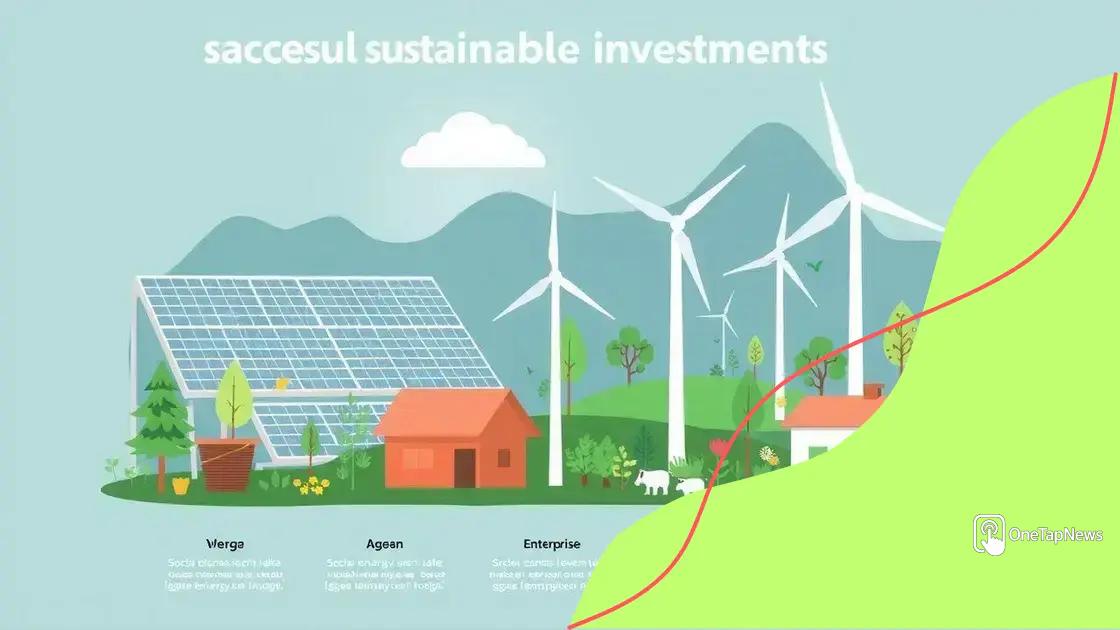Sustainable finance growth: unlocking new opportunities

Anúncios
Sustainable finance growth integrates environmental and social considerations into financial decision-making, driven by technological advancements, regulatory changes, and increasing demand for green investment products.
Sustainable finance growth is more than a buzzword; it’s transforming how we view investments today. Have you wondered how it affects your financial decisions? Let’s dive into this topic together.
Anúncios
Understanding sustainable finance
Understanding sustainable finance is essential in today’s world. As we become more aware of our environmental impact, financing that supports sustainability initiatives has gained traction.
Sustainable finance refers to the integration of environmental, social, and governance (ESG) criteria into financial services. This helps investors and companies assess the risks and opportunities tied to sustainability.
Key Concepts in Sustainable Finance
At the heart of sustainable finance are several concepts that drive its importance:
Anúncios
- Green Investments: These focus on projects that benefit the environment.
- Social Responsibility: Investments that consider social impacts matter as much as financial gains.
- Governance: Strong governance ensures transparent and responsible business practices.
Understanding these concepts is vital for anyone looking to engage in sustainable finance. The goal is to align investments with values that promote positive societal impact.
As we look at the financial landscape, more institutions are adopting sustainable finance practices. This shift not only reflects changing investor expectations but also acknowledges the risks associated with climate change.
The Role of Financial Institutions
Banks and investment firms play a crucial role in sustainable finance. They are developing products tailored to meet the needs of environmentally conscious clients. Examples include:
- Sustainable Bonds: These fund projects aimed at reducing carbon footprints.
- Green Loans: Loans provided to businesses that adhere to sustainable practices.
- Impact Investing: Focused on generating social or environmental impact alongside financial returns.
A growing number of investors are prioritizing sustainable finance, eager to support practices that align with their beliefs. This movement pushes businesses towards greater accountability and innovation.
Challenges and Opportunities
While sustainable finance is promising, it also faces challenges. Issues such as lack of standard definitions and measurement can hinder progress. However, these challenges present opportunities for growth and improvement in the industry.
Organizations are now exploring how to better define and measure the impact of their investments, aiming for transparency and clarity in their offerings. As a result, we can expect continued evolution in the sustainable finance sector.
Key drivers of sustainable finance growth
Key drivers of sustainable finance growth are shaping the investment landscape today. Understanding these drivers helps investors navigate opportunities that align with both financial goals and environmental responsibility.
One primary driver is the increasing awareness of climate change. As more people recognize its impact, there’s a growing demand for investments that support sustainable practices. This shift influences how businesses operate and investors make decisions.
Regulatory Changes
Regulatory changes have also played a significant role in the growth of sustainable finance. Governments worldwide are implementing policies to encourage green investments. They are setting strict guidelines for businesses to follow, focusing on:
- Carbon Emission Reduction: Regulations incentivize companies to lower their carbon footprints.
- Transparency: Investors demand clear reporting on sustainability efforts.
- Tax Benefits: Incentives are available for sustainable projects.
Such regulatory measures create a more favorable environment for sustainable finance, attracting more investors and firms to participate.
Another key driver is the rise of socially responsible investing (SRI). Investors increasingly want their money to reflect their values. They seek to support companies that prioritize sustainability alongside profitability. This focus leads to a surge in demand for sustainable investment products, compelling firms to innovate and offer greener options.
Technological Advancements
Technological advancements further boost the growth of sustainable finance. Innovations in renewable energy and energy-efficient technologies empower businesses to operate sustainably. For example, breakthroughs in solar and wind power generation provide cleaner alternatives to fossil fuels.
Moreover, technology enhances the tracking and reporting of sustainability metrics. Improved data analytics enables investors to make informed decisions, evaluate risks, and assess the impacts of their investments on the environment. This transparency fosters trust in the market.
Investors are also now motivated by changing demographics. Younger generations, such as millennials and Gen Z, prioritize sustainability. They drive demand for investments that contribute positively to society and the environment. Their preferences push companies to adopt more sustainable practices to attract these conscientious investors.
Examples of successful sustainable investments

Examples of successful sustainable investments showcase the potential of aligning financial returns with positive environmental impact. These investments highlight how businesses can thrive while making a difference.
One prominent example is the rise of green bonds. These bonds raise funds specifically for projects that contribute to environmental benefits. For instance, a city might issue green bonds to finance renewable energy projects or sustainable infrastructure.
Renewable Energy Projects
Investing in renewable energy has proven to be a lucrative and sustainable approach. Companies focused on solar, wind, and hydroelectric power are attracting significant investments. These sectors not only help in reducing carbon emissions but also offer substantial financial returns.
- Solar Power: Companies like First Solar and SunPower lead in solar technology.
- Wind Energy: Firms such as Vestas and Siemens Gamesa provide cutting-edge wind turbines.
- Hydropower: Companies like Brookfield Renewable Partners invest in large-scale hydropower plants.
These examples illustrate how investing in renewable energy contributes to both profitability and environmental benefits.
Another successful investment area is sustainable agriculture. This sector promotes farming practices that reduce environmental impact. Some investors are funding companies that focus on organic farming or innovative sustainable practices. These investments engage consumers who prefer eco-friendly products.
Impact Investing
Impact investing is another way to achieve financial returns while contributing to societal goals. Funds that specialize in impact investing focus on companies addressing social and environmental challenges. This strategy attracts socially conscious investors seeking to make a difference.
Examples include:
- Microfinance Institutions: These provide loans to entrepreneurs in developing countries.
- Sustainable Real Estate: Companies developing energy-efficient buildings.
- Social Enterprises: Businesses that generate profits while benefiting communities.
These investments prove that profitability and sustainability can go hand in hand, paving the way for a brighter future.
Challenges in the sustainable finance sector
Challenges in the sustainable finance sector can hinder the progress of investments aimed at promoting eco-friendly practices. Understanding these obstacles is vital for investors looking to navigate this landscape.
One major challenge is the lack of standardized metrics for measuring sustainability. Investors often struggle to compare different sustainable investment options due to varying definitions of what constitutes ‘sustainable.’ This can lead to confusion and mistrust.
Regulatory Uncertainty
Regulatory uncertainty is another significant hurdle. As governments around the world implement new policies, the rules can change frequently. Investors may hesitate to commit funds when they are unsure how regulations will evolve. Such instability can create a risk-averse mentality, slowing down investment in sustainable projects.
- Inconsistent Policies: Different countries may have varying standards for sustainability.
- Changing Regulations: Frequent updates can create uncertainty for investors.
- Compliance Costs: Meeting diverse regulatory requirements can be expensive.
These regulatory issues create an environment where investors may feel uncertain about the viability of their investments.
Another challenge is access to capital. Many sustainable projects require substantial upfront investment. Smaller businesses, in particular, may struggle to secure funding from traditional financial institutions that prioritize immediate returns over long-term environmental benefits.
Market Perception
The perception of sustainable finance as a niche market can also be limiting. Some investors still view sustainable finance as less profitable than traditional investments. This belief may deter capital from flowing into sustainable projects, despite their proven potential for returns.
Moreover, the complexity of assessing social and environmental impacts can make investors hesitant. Investors may lack the knowledge or expertise to evaluate sustainable investment opportunities effectively. This knowledge gap can prevent many from exploring this lucrative market.
Finally, competition for limited resources presents another challenge. As more investors gravitate towards sustainable finance, the competition for the best projects escalates. This can lead to inflated prices and challenges in securing prime investment opportunities.
Future trends in sustainable finance innovations
Future trends in sustainable finance innovations are shaping the way investors approach opportunities for positive impact. As the world continues to focus on sustainability, we can expect several exciting developments in this field.
One major trend is the growing reliance on technology. Fintech companies are emerging with innovative solutions that enhance sustainable investing. These solutions include platforms for assessing the environmental impact of investments and automating the tracking of sustainable practices.
Integration of AI and Big Data
The integration of AI and big data is revolutionizing sustainable finance. By analyzing large datasets, investors can gain insights into how companies perform against sustainability criteria. AI algorithms can predict trends and evaluate risks associated with investments, enabling more informed decision-making.
- Enhanced Analytics: Predictive modeling helps identify investment opportunities.
- Risk Assessment: AI can evaluate potential environmental and social risks.
- Customized Portfolios: Investors can create tailored portfolios based on impact criteria.
This data-driven approach allows for more transparency in sustainable investing, encouraging investors to connect their values with their financial goals.
Rise of Green Financial Products
Another trend is the rise of innovative green financial products. Sustainable bonds and impact funds are becoming more mainstream. These products allow investors to support projects that align with their values while achieving financial returns.
Green bonds, for instance, raise capital for environmentally beneficial projects. Impact funds focus on generating measurable social or environmental impacts alongside financial returns. These products appeal to a growing number of conscious investors.
Additionally, there is an increasing focus on circular economy investments. The circular economy model promotes recycling and reusing materials, reducing waste. Companies that adopt these principles attract investment as they work towards long-term sustainability.
Collaboration and Partnerships
Collaboration among stakeholders is essential for driving sustainable finance forward. Public-private partnerships can fund ambitious projects that larger enterprises might find challenging to undertake alone. By bringing together resources and expertise, these partnerships can create significant impact.
Furthermore, communities and local governments are becoming active participants in sustainable finance. Their involvement ensures that investments meet local needs and contribute to community development. This trend emphasizes a more holistic approach to sustainability.
FAQ – Frequently Asked Questions about Sustainable Finance
What is sustainable finance?
Sustainable finance refers to investments that take into account environmental, social, and governance (ESG) criteria, aiming to contribute positively to the economy while supporting eco-friendly practices.
How can technology improve sustainable finance?
Technology, especially AI and big data, helps analyze investment opportunities, assess risks, and enhance transparency in sustainable finance, enabling smarter decision-making.
What are green financial products?
Green financial products include investments like green bonds and impact funds that specifically raise capital for projects with positive environmental impacts.
What challenges does the sustainable finance sector face?
Challenges include regulatory uncertainty, lack of standardized metrics, access to capital for smaller projects, and market perception that sustainable finance is less profitable.